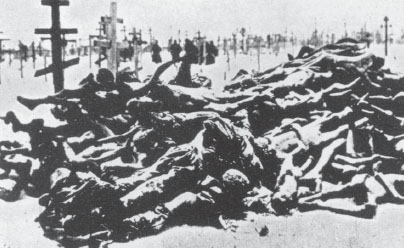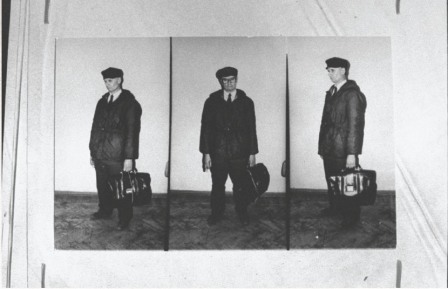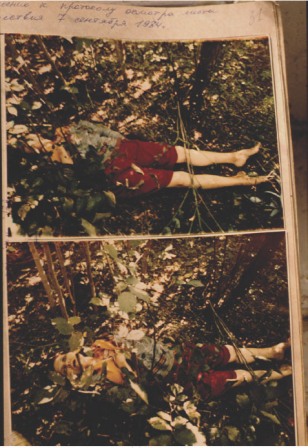THE LURKING COMMUNIST

Name: Andrei Chikatilo
DOB: 16 October 1936
Profession: Employee of shipping firm
Upbringing: Born at a time of famine; told that his brother had been eaten by ravenous neighbours; chronic bed-wetter
Description: His head was misshapen from water on the brain as a child; called himself ‘a mistake of nature’
Previous convictions: Career as a teacher was blighted by accusations he had molested pupils of both sexes
Number of victims: 52 at least
Even as the USSR retreats into history, there is something almost surreal in the grouping of the words ‘Soviet serial killer’. Rightly or wrongly, the phenomenon often seems so much a symptom of the West. How incredible, then, that a serial killer from the Soviet Union was more prolific and, one might claim, more sadistic than any of his Western contemporaries. Andrei Chikatilo is thought to have raped and killed at least 52 people of both sexes. He mutilated their bodies, often in ways reminiscent of Jack the Ripper.
Andrei Romanovich Chikatilo was born on 16 October 1936 in Yablochnoye, a village in what is now Ukraine. As a child he suffered terribly, growing up with the after-effects of the Ukrainian famine. His mother often told him a story that he’d had an older brother, Stepan, who had been kidnapped and then consumed by starving neighbours.
No documentary evidence supports the existence of this sibling.
After the Soviet Union entered the Second World War, when he was 4, his father went off to fight. Chikatilo was left alone with his mother, sharing her bed each night. A chronic bed-wetter, he was beaten for each offence. As the war progressed, he was witness to the Nazi occupation and the massive devastation and death caused by German bombing raids. Dead bodies, not an uncommon sight, were things he found both frightening and exciting.

Chikatilo was born in the aftermath of the Ukrainian famine of the 1930s
The end of the war brought little happiness to the Chikatilo household. His father, who had spent much of the conflict as a prisoner of war, was transferred to a Russian prison camp.
Outsider
Awkward and overly-sensitive, Chikatilo withdrew from other children. He was considered a good student, but failed his entrance exam to Moscow State University. In 1960, after finishing his compulsory military service, he found work as a telephone engineer. It was during this period that Chikatilo, now 23 years old, attempted his first relationship with a woman. He found himself unable to perform sexually, a humiliation that his prospective girlfriend spread among his acquaintances. As a result, he developed elaborate fantasies of revenge in which he would capture the woman and tear her apart.
Now 23 years old, Chikatilo attempted his first relationship with a woman. He found himself unable to perform sexually…
When Chikatilo married, in 1963, it was through the work of his younger sister, who made the arrangement with one of her friends. He suffered from chronic impotence, yet managed to father a son and daughter.
Late in life it was discovered that he had suffered brain damage at birth, which affected his ability to control his bladder and seminal emissions.
In 1971, after completing a degree in Russian literature through a correspondence course, he managed to get a teaching position at a local school. Though a poor instructor, Chikatilo continued in the profession for nearly a decade, often dodging accusations that he had molested his students.
In 1978, having accepted a new teaching position, Chikatilo moved to Shakhty. Living alone, waiting until his family could join him, he began to fantasize about naked children. Chikatilo bought a hut off a shabby side street from which he would spy on children as they played, all the while indulging in his solitary practices. Three days before Christmas, he managed to lure a 9-year-old girl, Yelena Zabotnova, into his lair. He had intended to rape the girl, but found himself unable to achieve an erection. He then grabbed a knife and began stabbing her, ejaculating in the process. He later disposed of the girl’s body by dumping it into the Grushovka River. Chikatilo was a suspect in the crime; several witnesses had seen him with the girl and blood was discovered on his doorstep. However, another man, Alexsandr Kravchenko, confessed to the murder under torture. Kravchenko was subsequently executed.

In a world where censorship ruled, rumours rapidly spread that a werewolf was the killer
Chikatilo’s good luck did not transfer to his new school. In 1981, he was dismissed after molesting boys in the school dormitory. Through his membership of the Communist party, he was soon given a position as a supply clerk at a nearby factory.
Though he did not kill again until the 3 September 1981 murder of Larisa Tkachenko, Chikatilo had begun a series of murders that lasted until the month of his capture, 12 years later.
Chikatilo most often preyed on runaways and prostitutes who he found at railway and bus stations. Enticing his victims with the promise of cigarettes, alcohol, videos or money, he would lead them into nearby forests. The corpse of one young female runaway, discovered in 1981, is typical of the horrific scenes Chikatilo would leave behind. Covered by a newspaper, she was lacking her sexual organs. One breast was left bloody by a missing nipple. Chikatilo later admitted that he had bitten and swallowed it, an act which caused him to ejaculate involuntarily.
His male victims, all of whom ranged in age from 8 to 16, were treated in a different manner. It was Chikatilo’s fantasy that each was being held prisoner for some undisclosed crime.
He would torture them, all the while fantasizing that he was a hero for doing so. Chikatilo would offer no explanation as to why, more often than not, he would remove the penis and tongue while his victim was still alive.
Many of his early victims had their eyes cut out, an act performed in the belief that they would provide a snapshot of his face. The practice all but stopped when, upon investigation, Chikatilo realized this to be an old wives’ tale.
There can be little doubt that Chikatilo was greatly aided in his crimes by the state-controlled media of his time. No-one knew what was going on. Reports of crimes like rape and serial murder were uncommon, and seemed invariably to be associated with what was portrayed as the hedonistic West.

Police photographs of Chikatilo carrying the black bag which contained the knives used on his victims
While close to 600 detectives and police officers worked on the case, staking out bus and train stations, and interrogating suspects, those living in the areas where the bodies were found were entirely unaware that there might be a serial killer in their midst. Still, with over half a million people having been investigated, there were bound to be rumours.
One story had it that boys and girls were being mauled by a werewolf. It was not until August 1984, after Chikatilo had committed his 30th murder, that the first news story was printed in the local party daily.
Suspicious behaviour
On 14 September 1984, there was a break in the case when an undercover officer spotted Chikatilo approaching various young women at the Rostov bus station. When questioned, Chikatilo explained that, as a former schoolteacher, he missed speaking with young people. The explanation did nothing to allay suspicions and the officer continued to trail Chikatilo. Eventually, the former teacher approached a prostitute and, after having received oral sex, was picked up by the police. His briefcase, when searched, was found to contain a kitchen knife, a towel, a rope and a jar of petroleum jelly.
There was a break in the case when an undercover officer spotted Chikatilo approaching young women at Rostov bus station
So certain were the authorities that they had their serial killer that the prosecutor was asked to come and interrogate Chikatilo. However, any celebration was cut short when it was discovered that Chikatilo’s blood type did not match that of the semen found on the victims’ bodies. This discrepancy, which has never been satisfactorily explained, is most often considered the result of a clerical error. After two days, Chikatilo was released, having admitted to nothing more than soliciting a prostitute.

The body of Tanya Petrosan, 32, who was murdered in 1984
There is the possibility that Chikatilo would have remained under interrogation for a longer period had it not been for the fact that he was a member of the Communist party.
This association would quickly come to an end weeks after his near-capture when he was arrested and charged with petty theft from his workplace. Chikatilo was expelled by the party and sentenced to three months in prison.
After his release, Chikatilo found new work in Novocherkassk. His killing began again in August 1985 and remained irregular for several years. By 1988, however, he seemed to have returned to his old ways, murdering at least nine people.
And yet it appears he took no life during the calendar year that followed. In 1990, he killed nine more people, the last being on 6 November, when he mutilated Sveta Korostik in the woods near the Leskhoz train station.
With the station under constant surveillance, Chikatilo was stopped and questioned as he emerged from the area where the body would later be discovered.
Within the next 15 days, he confessed to and described 56 murders. The number shocked the police, who had counted just 36 killings during their investigation
On 14 November, the day after Sveta Korostik’s body was discovered, Chikatilo was arrested and interrogated. Within the next 15 days, he confessed to and described 56 murders. The number shocked the police, who had counted just 36 killings during their investigation.
Crazy outbursts
Chikatilo finally went to trial on 14 April 1992. Manacled, he was placed in a large iron cage in the middle of the courtroom. It had been constructed specially for the trial, primarily to protect him from the families of his victims. As the trial got under way, the mood of the accused alternated between boredom and outrage. On two occasions Chikatilo exposed himself, shouting out that he was not a homosexual.
Chikatilo’s testimony was equally erratic. He denied having committed several murders to which he’d already confessed, while admitting his guilt in others which were unknown. Claiming other murders as his own seemed less bizarre than other statements. At various points Chikatilo announced that he was pregnant, that he was lactating and that he was being radiated. On the day the prosecutor was to give his closing argument, Chikatilo broke into song and had to be removed from the courtroom. When he was brought back and offered a final opportunity to speak, he remained mute.
On 14 October 1992, six months after his trial had begun, Chikatilo was found guilty of murdering 21 males and 31 females. All of the males and 14 of the females had been under the age of 18.
Throughout the trial, Chikatilo’s lawyer had made repeated attempts to prove that his client was insane, but a panel of court-appointed psychiatrists dismissed the claim. An appeal having been rejected, on St Valentine’s Day, 1994, Chikatilo was taken to a special soundproof room and executed with a single gunshot behind his right ear.
Danger signs: As a young teacher he spent his free time watching children, picturing them naked
Pattern of crime: Impotence exacerbated his feelings of inadequacy; found he could only achieve an erection while stabbing and slashing victims
Breakthrough: Observed by undercover policeman trying to lure young women from Rostov bus station
Behaviour in court: Exposed himself in court, crying out he was not homosexual; broke into song and refused to answer questions
Plea for the defence: ‘I considered them [his victims] enemy aircraft to be shot down’
Sentence: Death (gunshot to the head in a soundproofed room)